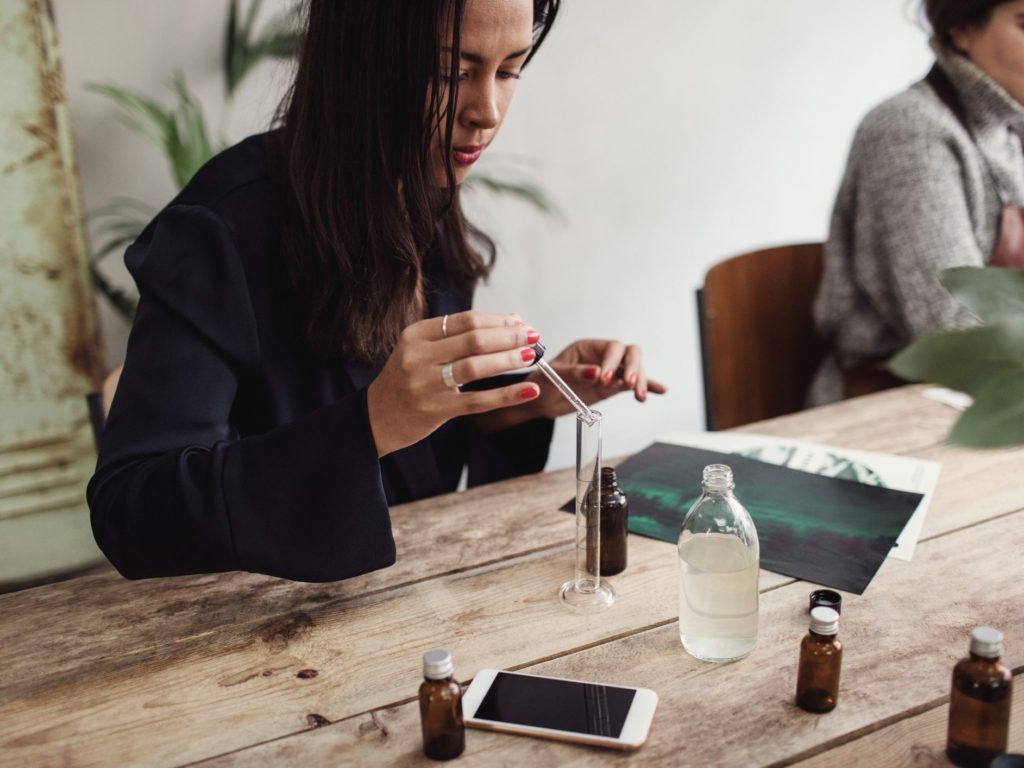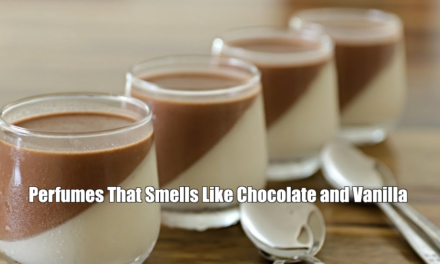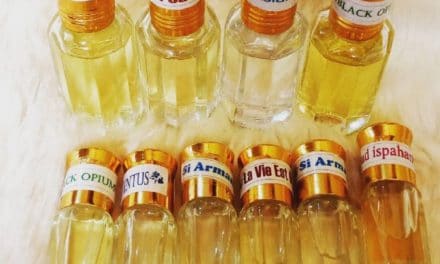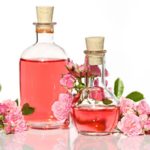![Carolina Herrera Bad Boy Review: Does It Last Longer? [2024]](https://bestperfumes.reviews/wp-content/uploads/2021/10/CAROLINA-HERRERA-BAD-BOY-Review-150x150.jpeg)
The Ingredients For Making Perfume of High Quality [2024]
![The Ingredients For Making Perfume of High Quality [2024]](https://bestperfumes.reviews/wp-content/uploads/2021/01/Ingredients-For-Making-Perfumes.jpg.png)
In the past, the art of perfume making relied majorly on aromatic oils and flowers, and this kind of limited output and at the same time denied it variance. However, the much modern perfume industry has seen the emergence and surge of materials such as essential oils or natural extracts, fragrance oils and other synthesized aroma compounds (like coumarin and synthetic musks) that are now commonly used in the production of commercial perfume brands.
On a broader classification, raw materials for making perfumes fall under three categories which include: synthetic chemicals, naturally-gotten essential oils, and semi-artificial materials that are gotten when natural raw materials are processed chemically.
Based on this, it is safe to say that a specific perfume brand is synthetic, natural, or semi-synthetic due to the nature of raw materials used in its production.
Generally, ingredients for making perfumes simply refer to the singular raw materials that a particular fragrance consists of. They are basically the building blocks of every fragrance and can come from plants and animals, or be manufactured as an entirely new product.
Sources Of Ingredients Used In Making Perfumes
Plant Sources: Like the name, raw materials for making perfumes can be sourced from plants and are one of the oldest and largest raw materials used in the production of perfumes. Plants give out essential oils and other aromatic substances that form the bedrock of almost all fragrance.
Ironically, it is no news that some of these materials extracted from plants are natural products produced by bacteria, fungi and the likes, which are not part of their daily biological functions but are meant to protect them against diseases and herbivores.
Plant sourced ingredients are usually extracted from their sources through processes like solvent extraction (or maceration), pervaporation, expression, cold mechanical pressing, distillation, and cryoconcentration.
However, these processes of extraction often affect the scent concentration (in varying degrees) or destroy the compounds contained in the raw materials. The usual parts sourced from plants include:
Seeds: Seeds are common features in the world of perfume making, and the most common ones include: anise, nutmeg, tonka beans, coriander, cocoa, carrot seed, cardamom, and the rest.
Bark: Tree barks are common ingredients for making perfumes. They are either used as raw materials directly or are subjected to further processing to give off products like oils and extracts that are used to produce perfumes. The widely used ones are cascarilla, sassafras, sandalwood, juniper, agarwood, pine, and cinnamon.
Fruits: Fruits are not so commonly used in crafting perfumes because they hardly give off the extracted flavours needed, and so perfumers often depend on the synthetic flavours of such fruits. The few that do do so from their rinds and include mostly citrus fruits like oranges, limes, and lemons. However, more synthetic versions of these citrus fruits are being used within perfumery in order to eliminate some of the harsh chemicals they contain.
Blossoms/flowers: the use of flowers and blossoms goes back to the earliest attempts to create fragrances and aromatics in the past. The most common flowers used in producing perfumes include roses, citrus tree blossoms, jasmine, mimosa, osmanthus, tuberose, plumeria, narcissus, and the rest. Some of these flowers are processed to give out sweet-smelling oils that are used to create fragrances.
Roots/bulbs – there are few roots used in perfumery and they include: vetiver, ginger and iris rhizomes.
Resins: Resins (either in the form of gums or the flowers these trees bear) have attained a hall of famer presence in the history of making perfumes, antiseptics, and incenses. The widely used resins include: myrrh, frankincense, benzoin, balsam of Peru, labdanum, pine, and fir resins. With the last two being natural sources of terpenes, an organic substance used to create other aromatic compounds.
Leaves: Leaves are typically known for the “green notes” they bring to perfumes. The most commonly used leaves for making fragrances include: patchouli, citrus leaves, hay, sage, rosemary, lavender leaf, tomato leaf, violets, and others.
Woods: Woods are popular ingredients that are liked by most perfumers due to the unique scents they bring and their base note functions. The most commonly used woods include: sandalwood, agarwood, cedarwood (all the variants), rosewood, pine, birch, juniper, and others. They are often refined to extract other properties they contain that are of benefits to the perfumer.
Additional natural sources: Like lichen and seaweed are also used as direct materials or are further refined to produce oils and other extracts that are used to create fragrances. Examples of lichen and seaweeds used are oakmoss, bladder wreck, treemoss thalli, and others. Most importantly, seaweed oils are expensive and most perfumers rely on the synthetic variants of these oils instead of going for the real stuff.
Animal Sources
Raw materials gotten from animals exist as the ‘adjacent’ natural product standing side by side with raw materials derived from plant sources. They are often extracted through various means, both ethical and unethical.
Musk: Musk is a fragrant secretion extracted from the anal glands or genitals of the male musk deer and is up to 5cm in length. In the history of traditional medicine, it was first used as a sexual stimulant and for therapeutic purposes before being incorporated within perfume making as a perfume fixer and base note ingredient.
For the sake of its popularity and controversial means of extraction, with the most popular musk variant coming from the Indian deer, its use has been discounted or banned in most countries for perfume making due to how it is extracted. However, this has not interrupted the supply as it can still be bought at the black market at a steep price.
In the place of secretions like musk, other synthetic alternatives have sprung up acting as perfume fixers and discouraging the use of animal-based raw materials. Good examples of such synthetic product are ambrettolide and polycylic musk.
Hyraceum: Hyraceum comes in a solid excrement in a rock-like form that contains both urine and faeces excreted by the African and Middle East rock badger. Before being used as an ingredient for making perfumes it has been used in as a constant component in traditional medicine practice in South Africa.
Also known as the “African stone”, it gives off a deep and animalic smell that seems like a combination of musk, tobacco, civet, agarwood, and castoreum. Hyraceum is preferred by most perfumers because this raw material is gotten without harming the animal source. It then becomes an ethical alternative for raw materials that involve hurting the animal sources such as deer musk and civet.
Civet: Civet is a secretion from a mammal that closely resembles a fox. It exudes an animalic scent which is quite understandable as this substance is given off to attract a mate. It is popular in male perfumes and is widely used as fixative. In addition, there is a synthetic alternative of this animal raw material, and it is known as civetone.
Castoreum: Castoreum is another animal secretion and is gotten from the anal sacs of both the North American and European beavers. This secretion comes in an oily form and is released by the beaver as a substance for body grooming, for protecting its fur, and for marking its territory. Due to its powerfully animalic smell and fixative qualities, it is a regular featured ingredient in most fragrances for men
Ambergris: Ambergris is another widely used raw material from sperm whales. It is produced by sperm whales as an organic product that protects and heals their stomach from harm induced by the sharp beaks of the cuttlefish they are known to eat. At the time it is expelled as vomit from the sperm whale it has a foul smelling odour that would make most people doubt its usefulness within perfumery.
However, after years of floating, curing, and hardening the salty water transforms it into one of the most costly animal materials used for producing perfumes. This has changed though, with the emergence of newer synthetic raw materials like ambroxan and amberlyn. When tinctured, it is popular base in floral and oriental fragrances.
Honeycomb: Honeycomb is gotten from bees and is used to make beeswax absolute. For this process ethanol is used and when evaporated gives what is generally known as beeswax absolute.
Synthetic Sources
Synthetic raw materials are artificially made materials that do not exist in nature and are only made due to the growing demands of some naturally existing fragrant raw materials used in most perfume brands.
They exist as the artificial alternatives and are made of scents that are not derived naturally from living sources. Also, some of these synthetic materials are produced by the companies for the sake of making commercial perfumes and are patented intellectual products.
However, artificial raw materials are not all bad as the image already painted, this is because such innovations have kept the business of crafting perfumes afloat and has also brought new scents into existence which ordinarily wouldn’t have existed, and especially those ones that cannot be sourced directly from nature (like oceanic scents and scents that smell like waterfalls). Also, synthetic materials are often gotten through crude oil isolation and natural isolation. Some of the famous artificial raw materials for making perfumes include:
Ambrettolide: Ambrettolide is naturally gotten from the ambrette seed oil and then transformed into a synthetic musk that comes into fragrances as a musk note. It becomes a good alternative to the natural musk and helps in improving and balancing out fragrances. As fixatives, they bring depth and intensity to any fragrance blend they are added to. As a base note, it belongs to the musk family and mixes well with spicy, woody, and floral scents.
Coumarin: As a chemical compound, coumarin has a sweet green and tasty aroma that reminds one of vanilla. Though found naturally in some plants like Tonka bean, sweet clover, and lavender, coumarin is often produced artificially as a way of cutting cost and maximizing its essence value.
Exaltolide: Exaltolide is an artificially-produced musk and often acts as an alternative to organic animal musk. It exudes an elegant and soft musk scent that closely reminds one of a soft and clean skin. It mixes well with sweet, fruity, floral, woody, earthy, and woody scents.
White musk – white musk or musk ketone is a synthetic musk product and gives off a soft and powdery baby-like aroma. It is a perfect base note and ensures increased longevity and sillage of fragrances.
Muscone: Muscone is the molecular compound behind the characteristic original musk scent. Nowadays, it is synthetically produced and gives off an animalic aroma that is both seductive and alluring. This material mixes well with woody, citrus, spicy and floral scents.
Linalool: Linalool exists as a clean floral and sweet citrus aroma that is similar to the natural scents given off by the French lavender, birch, mint plants, and bergamot. It can now be produced synthetically and is often used as a base note in fragrances.
Iso E Super: Iso E super is a synthetic fixative incorporated into fragrances to increase its longevity, fullness, and strength. As an aromachemical, it has large molecules that make the smell ‘anosmic’ or almost undetectable when it stands alone.
But this changes when combined with other ingredients as it gives off this subtle woody and amber note that makes it a popular choice for most perfumers. Also, it clings closely to the skin with a transparent and velvety vibe that feels comfortable. It mixes well with woody scents, floral scents, musky scents, and fruity scents.
Classification Of Ingredients Used In Making Perfumes According To Fragrance Family

Ingredients Sourced From Woods
Amber: Amber oil (which is the form of raw material used here) is gotten from fossils of the Baltic amber tree. This oil is derived from a distillation process that involves refining the over high heat and then extracting the oil. Amber comes into fragrances as a fixative base, and helps to increase longevity and intensity. As a woody base, it exists as an essential oil that mixes well with spicy, woody, sweet, musky, and floral scents.
Agarwood: Agarwood or eaglewood is a resinous wood that forms in the core of the acquillaria tree as a result of a bacterial or fungal attack on the tree. Once attacked the tree produces an oil at the affected places and over time this oil hardens and darkens to become the popular oud oil favoured by perfumers all around the world.
Like its Asian roots, Oud oil carries a sensual, oriental and exotic scent that brings depth and longevity to any fragrance mix. This raw material remains a popular demand due to its distinctive smell and is often tagged as the most expensive wood in the wood.
Sandalwood: Formerly existing as the Mysore sandalwood (santalum austrocaledonicum), this Indian variant is one of the oldest ingredients for making perfumes from its earliest use as an ingredient in official incenses.
However, its use has dwindled over the years as it has become an endangered species and the attention has shifted to more eco-friendly and sustainable variants like different sandalwood species and include sandalwood from Vanuatu, and sandalwood from Australia (both the organic and absolute variants).
The Indian sandalwood gives off a sweet woody scent that is both soft and consistent for a long period of time. It is a preferred base scent due to its versatility and underwhelming feel. However, the newer variants of this wood lack the original scent that Mysore Sandalwood gives. It mixes well with floral scents, woody scents, spicy scents, and musky scents.
Vetiver or vetyver: Vetiver (vetiveria zizanioides) comes in the form of an essential oil and is gotten from the dried fribrous and heavy roots of the vetiver grass. It gives off a smoky, woody, earthy, leathery, and slightly later sweet undercurrent. It also exists as a fixative used in many perfume brands, especially male perfumes.
As a base note, it mixes well with spicy, citrus, woody, earthy, and chypre scents. There are many variants of vetiver and is differentiated based on their origin and distinct scent. However, the most commonly used variant is the Haitian vetiver, and there are others like Indonesian vetiver, Malaysian vetiver, and Sri Lanka vetiver.
Patchouli: Patchouli is a woody note commonly used as a base note in most fragrances. As a base ingredient, it brings polarity to fragrances with its signature sweet and earthy scent that reminds one of wet soil. It is also used as a fixative which increases the life of other notes within fragrances and is extracted as an oil from dried patchouli leaves through steam distillation.
It exists as an intense base that needs that needs to be diluted before use and can be used sparingly. This essential oil blends well with other oils, especially the musky and woody oils that include: bergamot, sandalwood, cedarwood, vetiver, jasmine, citrus, frankincense, and the rest.
In the 1960s, it was very popular as a fragrance type within hippie communities and has seen grown to become a universal ingredient used by perfumers all over the world.
Guaiac wood: Guaiac wood is a hard wood that comes from the stripped heart wood of the small tree Palo Santo (Bulnesia Sarmienti) which translates as “tree of life”. This exotic brings a distinct smell to fragrances, with this smell often described as smoky, rubbery, and tar-like.
As a base ingredient in perfumes, it is a common component in tobacco and leather scents. It mixes well with other woody scents, spicy scents, and sweet scents.
Oakmoss (evernia prunastri): Oakmoss comes from a lichen that grows on oak tree. Prominent as a woody base, it exists as a foundational ingredient in Fougere and chypre scents. As a base raw material, it brings depth in the form of powerful undertones and a long-lasting feel to fragrances.
ALSO READ: How to Make Perfumes Last Longer – An In-depth Guide
Also, it is highly favoured for the powerfully distinct forest scent it brings to fragrances. As a popular ingredient in many commercial perfumes, it mixes well with other woody scents, citrus scents, floral scents, and green notes. However, the use of this raw material has been minimized due to numerous cases of the allergenic properties it contains.
Cedar Virginia (juniperus virginiana): Cedar Virginia is not really a wood but a juniper tree. It comes into perfumes as an essential oil and has a unique smoky, green, and evocative pencil aroma. It is lightly balsamic and with a smooth feel that makes it an ideal base ingredient for most fragrances. It brings out the fullness in fragrances and mixes well with musky scents, floral scents, citrus scents, woody scents, and spicy scents.
Cedar Atlas (cedrus atlantica): Cedar atlas is another type of the cedarwood oil and originates from the Atlas Mountains in Morocco. Out of all the cedarwood oils, it has sweetest and most mellow scent making it a great base ingredient within fragrances. In addition, it has a sweet and delicate woody feel. Furthermore, it mixes well with spicy scents, musky scents, citrus scents, and woody scents.
There is another type of cedarwood known as Himalayan Cedarwood, which originates from the Himalayans. It resembles the Cedar atlas in scent profile but has a soapy-clean scent that reminds one of the smell of white musk.
Forms Of Fragrant Extracts That Are Used In Making Perfumes
Within perfumery, it is important to know that refinement processes are a big deal and that the classification of a raw material often depends on the method used to extract it.
Essential oil: Essential oils are the most notable fragrance extracts and are simply oils extracted from the base sources either through distillation or expression. Such oils contain the “essence” of their source plants, which includes (but not limited to) the qualities of these plants. They are often very concentrated and need to be diluted before being used as ingredients in fragrance compositions.
Tincture: Tincture is gotten by soaking extracts or fragrant materials in vinegar or alcohol. The alcohol or vinegar works to pull out the needed ingredients in these extracts and concentrating them in a blend.
Absolute: Absolutes come in oily forms and are created through soaking plant extracts or fragrant sources in alcohol (preferably ethanol). Absolutes are similar to essential oil in their form and concentration but only differ in the method of production (which is solvent extraction or enfleurage)
Pomade: Pomade are sticky and oily solid animal fat with absorbed properties from their plant source and are gotten through the refinement process known as enfleurage.
Concrete: Concrete within fragrance composition exist as wax or thick liquids with an oil feel and is gotten from plants through a process known as solvent extraction.
Ingredients Sourced From Plants (Flowers, Citrus, And Resin Gums)
Neroli: Neroli within perfumery comes in the form of an oil extracted from the flower blossoms that the bitter orange tree (native to Italy) bears. This oil has a refreshingly sweet and floral fragrance that reminds one of the aroma of citrus on a spring morning, and on the other hand subtle layers of spicy and green notes.
Also, it is known to blend well with other oils and absolutes, and is a popular ingredient well-liked by perfumers around the world. When contained in a perfume, it is argued that it helps relieve stress and anxiety when applied. Within the perfume world there are variants of the neroli plant, with the best coming from France and Tunisia. This oil is extracted through steam distillation.
Tuberose: Not minding the name tuberose is not a rose at all, but rather is a flower that comes from the agave family native to Central America. This lily-like flower when processed yields an oil that smells both sweet and seductive.
The aroma is characteristically alluring and compulsive, with that fresh citrus feel that passes it off as the quintessential femme fatale scent. These dark and desirous qualities are why it was blacklisted it as a perfume fragrance during the Victorian period. Also, it blends well with other ingredients and is commonly used as middle or heart note in most luxurious spring and summer fragrances.
Bergamot: Bergamot is a hybrid (of bitter orange and lime) fragrant citrus that is the size of an orange but closely resembles a lime. The bergamot aroma on first application prominently resembles the earl grey tea, an understandable fact given that it is used to flavour grey teas. It has a tart, bitter, yet sweet aroma that is both refreshing and welcoming.
From Mediterranean origins, it gives off an oil that is extracted from the peel and used in making perfumes. It is commonly used as a top note or base note in fragrances.
Pink pepper: Looking more like a berry than pepper, pink pepper is gotten from the berry shrub, Schinus Molle or the Peruvian peppertree. The only connection it shares with pepper is their spicy and radiant feel. It has a typical feminine and exotic personality, making it a constant feature in most fragrances for women.
This ingredient comes as a top note that blends well with other notes, namely citrus scents, woody and floral scents. Pleasures, fragrance by Estee Lauder is the first fragrance to use pink pepper as a note.
Fennel: Fennel has a spicy, a subtle sweet, and base earthy aroma that makes it a main ingredient in most fougere fragrance compositions.
Lemon: Lemon is one of the popular citrus notes used in fragrances. Prior to being used as an ingredient for making perfumes, it was extensively in Asia as an antidote for poisons, healing wounds, and for cooking. Lemon is a source of lemon oil, this oil is extracted from the lemon peel through the process of cold-pressing and has a zesty and sharp citrusy scent that improves both mood and confidence of whoever wears the fragrance that contains this note.
This cold-pressing method of extracting this oil ensures that it retains its original feel and properties. As a light and sparkling top note, it blends well with commonly featured notes in fragrance mixes.
Black pepper: Black pepper is collectively hailed by many as the king of spices. Within perfumery, the spicy essential oil is extracted from the unripe fruit through the method of steam distillation. Black pepper as a heart note gives that olfactory kick that ushers in the top notes and also brings depth to every fragrance.
Also, it offers a balancing contrast and mixes well with floral, woody, and citrus notes. In certain cases, this ingredients requires a slight dilution before being incorporated into a fragrance.
Cardamom: Cardamom dates back to ancient Egypt where it was used as a teeth whitener and an aromatic ingredient. This piping hot and spicy herb comes from the same family as ginger. Before being used as an ingredient within perfumery, the seed is processed to extract the essential oil it contains.
It comes into fragrance blends as an aromatic contrasting middle or heart note that mixes well with other notes. This spice is expensive and is mostly used in many luxury and designer perfumes.
Vanilla: Vanilla belongs to the orchid family and is a popular spice due to its unique flavour. The form of vanilla used in creating fragrances is the sun-dried pods. It gives off a soothing and alluring base note and blends well with other ingredients. Both the extracts and essential oil are also used to make perfumes.
Myrrh: Myrrh dates as far back as biblical times when it was one of gifts offered to baby Jesus, and to ancient Egypt where it was used as a preservative. It has since evolved to become a natural resin used in making perfumes. It has an aromatic and woody scent and contrasts well with other notes.
Frangipani: Frangipani is a fragrant flower that grows in the tropics of South America and the Caribbean. Also known as plumeria, it gives off an essential oil that serves as the middle note or top note in fragrances blends. It is a floral fragrance and blends well with all notes.
Cinnamon: Cinnamon exists as a spice and is gotten from the bark of several trees belonging to the genus cinnamon. The oil it gives comes into fragrances as a heart note and gives a warmly sweet and spicy aroma.
Patchouli: Patchouli is a minty aromatic shrub that is distilled to produce an essential oil used in creating perfumes. It plays the important role of base note in oriental chypre, floral, and woody fragrance blends. It gives off a musky and earthy aroma with an intensity and depth depending on how long the oil has stayed.
Mandarin: Mandarin orange is a citrus tree with oriental origins. It is a source of the mandarin essential oil used in perfumery and aromatherapy. It gives off a sensual and soothing citrusy aroma that is very similar to that of neroli. It is a top note that mixes well with other variant notes.
Osmanthus: Osmanthus is an oriental fragrant flower that exists as a heart note in fragrances. With a strong floral scent, it helps highlight other notes in a fragrance, especially the woody and musky notes.
Clove: Clove is an aromatic spice gotten from the dried flowers of the clove tree. It is closely related to eucalyptus and myrtle, and produces a spicy and sweet essential oil. It occurs in fragrance compositions as a middle note and combines well with other spicy, floral, and woody scents.
Tangerine: Tangerine is another citrus scent that is incorporated into fragrances. It closely resemble orange (the bitter and sweet variants) both in physical appearance and in scent. But unlike the orange, it has a tart feel in addition to the usual sweet citrusy aroma. It often exists as a top note in fragrances and blends well with other fragrance families.
Lavender: Lavender is commonly used in feminine perfumes as it offers a soothing and captivating aromatic vibe. It can function as either a middle note or top note. It comes from the mint family and has many variants with distinct features. The essential oil it contains is extracted through the process of steam distillation.
Geranium: In the art of crating fragrances, geranium is known as pelargonium and gives off a floral and sweet scent that resembles the scent of both rose and lemon. Geranium has many variants that include: geranium rose, geranium rose, geranium absolute, and geranium absolute. It comes into fragrances as a middle note and blends well with other notes.
Eucalyptus: Eucalyptus is a favoured ingredient in fragrances due to its refreshing, alluring woody and minty aroma. The leaves of the eucalyptus plants are processed to get eucalyptus oil which is the material used in creating perfumes. Within fragrance blends, it is a top note and contrasts well with other notes.
Peach: Peach provides a rich aromatic and sweet fruity taste that is usually introduced to fruity and floral fragrances.
Strawberry: Strawberry has a strong and sweet flavour that is usually incorporated into many feminine and summer fragrances. It is also used in creating scents for kids.
Galbanum: Galbanum is a part brown part yellow resin gum that has an aromatic scent. It also gives off a fresh green and faint woody feel.
Leather: Leather exists as one of the oldest notes in perfumery. It exists as a base note and offers a grounding deep and intense scent that is both long-lasting and powerful. It is a typical ingredient in most male perfumes.
Green mandarin: It offers a sharp and fresh edge just like the mandarin, but with a slight difference. The extract needed here is the green mandarin oil which is wholly different from the mandarin oil due to the process of its extraction and the primary source (the peel of the unripe mandarin). It is a top note that blends well with musky, floral, and sweet notes.
Tonka bean: Tonka bean is pea that gives off a sweet, deeply musky, and spicy aroma which is due to the coumarin compound it contains. Tonka bean exists as a base note in the most intense fragrances providing the contrasting needed softness and calm, and also increases the longevity of notes.
Peppermint: Like the image it already has as an essential herb with an invigorating flavour, peppermint gives off a minty fresh and refreshing aroma. Existing in the form of essential oil, it comes into fragrance mixes as a versatile top note and blends well with other ingredients.
Jasmine grandiflorum: Jasmine is constantly used as a main perfume ingredient by perfumers around the world. It exists as a complex heart note and brings a sweet animalic and powerfully green feel to every fragrance blend. It is a constant feature in male perfumes as it brings elegance and a unique velvety balance that boosts confidence levels.
ALSO SEE: How To Make Perfume At Home – An Easy Step By Step Guide
Rose damascena: rose is traditionally dubbed the queen of flowers and gives off a soft floral and warm powdery aroma. As a heart or middle note, it is well complimented by citrus, musky, woody, and other floral notes.
Clary sage: clary sage comes from the Mediterranean region and exists as herb. This flowering herb gives off a green-like herbal and sweet essential oil that is often used as a middle note in perfumes.
Ylang ylang: Ylang ylang is a tree that bears the ylang ylang fragrant flower, which has a sweet and floral citrus aroma. When refined, it produces the ylang ylang essential oil that is used in as a heart note or base note perfume compositions.


![Chanel No. 5 Review: Does It Smell Good And Last Longer? [2024]](https://bestperfumes.reviews/wp-content/uploads/2021/10/Chanel-No-5-Review-440x264.jpeg)
![Dolce and Gabbana Velvet Rose Review: Is it a Quality Perfume? [2024]](https://bestperfumes.reviews/wp-content/uploads/2021/03/Dolce-and-Gabbana-Velvet-Rose-150x150.png)
![Dolce and Gabbana Velvet Pure Review: Does it Smell Good? [2024]](https://bestperfumes.reviews/wp-content/uploads/2021/03/Dolce-and-Gabbana-Velvet-Pure-Review.png)



![How to Make Perfume with Essential Oils: A Complete Step By Step Guide [2024]](https://bestperfumes.reviews/wp-content/uploads/2021/11/How-to-Make-Perfume-With-Essential-Oils.jpeg)

![Why Perfumes Fades So Quickly On the Body [2024]](https://bestperfumes.reviews/wp-content/uploads/2021/01/Why-Perfumes-Fades-So-Quickly-150x150.png)
![The Ingredients For Making Perfume of High Quality [2024]](https://bestperfumes.reviews/wp-content/uploads/2021/01/Ingredients-For-Making-Perfumes.jpg-150x150.png)